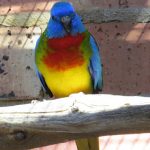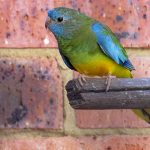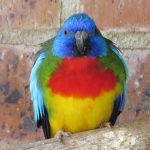SCARLET-CHESTED PARROT
The Scarlet-chested Parrot is native to Australia and is found in specific regions of the country.
Thinly distributed across the arid interior of southern Australia from far western NSW to the vicinity of Kalgoorlie (WA), extending as far north as southern Northern Territory.
Sometimes locally common and subject to local irruptions. Although rarely recorded in NSW, there are historical records from Menindee Lakes (1849), the ‘Darling River’ (1863), Bourke (1892) and near Broken Hill (1952). More recently, this species has been recorded occasionally in Danggali Conservation Park (SA) and in the adjoining Scotia Mallee (Tarawi NR, Scotia Sanctuary) in NSW. They primarily inhabit arid and semi-arid grasslands, spinifex plains, and open woodlands.
Adult males have a bright red chest, hence their name, transitioning to green on the upperparts and wings. The head is blue, with a black throat patch and a yellow face. Adult females and immature birds have a more subdued appearance, with predominantly green plumage and a yellowish chest.
These parrots primarily feed on grass seeds, as well as seeds from various herbaceous plants and shrubs. They are ground feeders, often foraging on the open ground or in short grasses, searching for food. They may also consume small amounts of fruits, berries, and insects.
Scarlet-chested Parrots are typically seen in small flocks or pairs. They are active and agile birds, known for their swift and direct flight, they may also exhibit seasonal movements in response to changes in food availability.
Breeding season for Scarlet-chested Parrots generally occurs during spring and summer, between September and February. They are cavity nesters, utilizing tree hollows or holes in termite mounds as nesting sites. The female lays a clutch of 4 to 6 eggs, which are incubated by both parents for approximately 19 to 21 days. After hatching, the chicks are cared for and fed by both parents until they fledge, which usually takes around 4 to 5 weeks.
The Scarlet-chested Parrot is listed as Vulnerable in NSW, local populations face threats from habitat degradation and changes in land management practices, including grazing and altered fire regimes.



